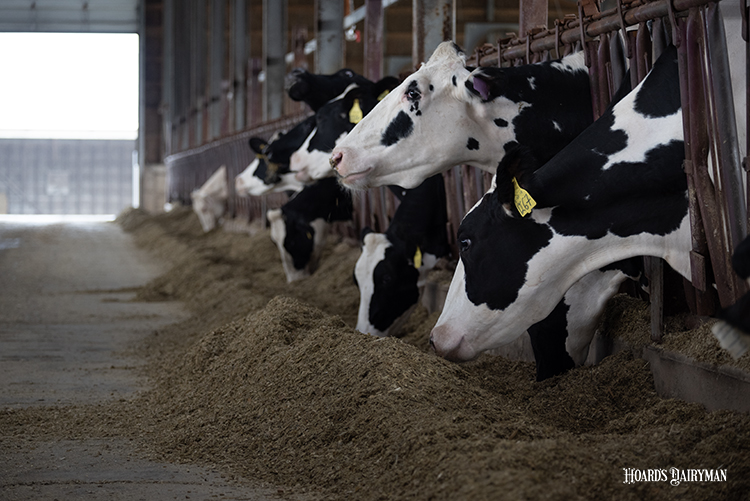
Most people only think of milkfat when they grab a jug of milk out of the dairy case. For dairy farmers, though, raising milkfat and protein levels is a goal for many, especially as milk components become more valuable.
The fat in milk derives from two sources. Some comes from fat present in the diet or body reserves; this can be considered “preformed” fat. Other fat results from synthesis in the udder, and this is called de novo or “new” fat.
During the March Hoard’s Dairyman webinar, Mike Hutjens, a professor emeritus with the University of Illinois, explained ways feeding and management can impact de novo fatty acid synthesis. He started by sharing data from the Miner Institute that showed a negative effect on de novo fatty acid synthesis.
The Miner Institute group found that less bunk space per cow, less than 18 inches per head, was related to less de novo fatty acids along with lower fat and protein tests. Along those same lines, a stall stocking density of more than 110% (greater than 1.1 cows per stall) also reduced de novo fatty acids, overall fat content and protein. These space limitations likely impacted feed availability and dry matter intake.
To maximize de novo fatty acid synthesis, Hutjens offered a few pieces of advice during the webinar. One is to feed more digestible fiber. “We know if we feed digestible fiber, we should get more formation of precursors for de novo synthesis,” he explained.
Next is to feed optimal start levels. “Starch can drive microbial growth, there’s no question about that, but you have to avoid subacute rumen acidosis (SARA), because that lower pH will hinder production of volatile fatty acids,” he shared.
If feeding rumen unsaturated fatty acids (RUFA), the rumen unsaturated fatty acid load (RUFAL) should be below 3% of the ration, Hutjens said. For polyunsaturated fatty acids (PUFA), that number is 2%.
More physical effective fiber in the diet is another way to maximize de novo synthesis, Hutjens noted, along with maintaining dry matter intake.
A note about soybeans
Hutjens discusses some fat sources that can be added to dairy cattle rations. Most feeds have some level of oil, around 2% to 3% of the ration. Nutritionists would recommend another 2% to 3% fat in the diet. This could come from oilseeds, animal fats where legal, and rumen inert dry fat sources.
Looking specifically at soybeans as an oil source, Hutjens said raw soybeans should be ground and limited to no more than 2 pounds per cow per day. Roasted soybeans must be cracked into quarters or eighths, and ensure optimal roasting temperatures and times, Hujtens advised. These can be fed up to 4 pounds per cow per day. Extruded soybeans should be limited to 2 pounds per cow per day because of the amount of free oil available when used in the ration.
To learn more about fat and protein sources in the ration, watch the March Hoard’s Dairyman webinar, “Strategies for boosting milk components.” This webinar was sponsored by QLF.








